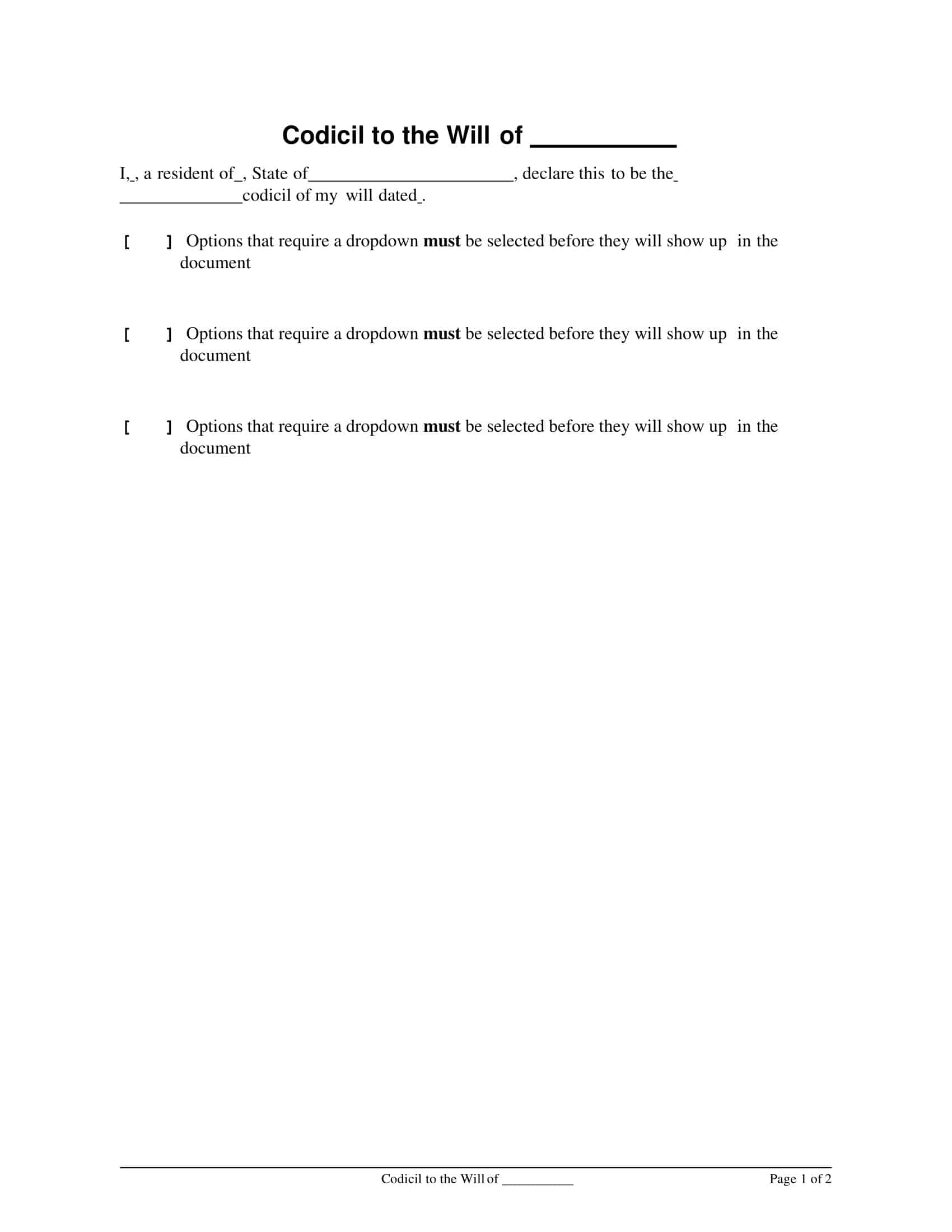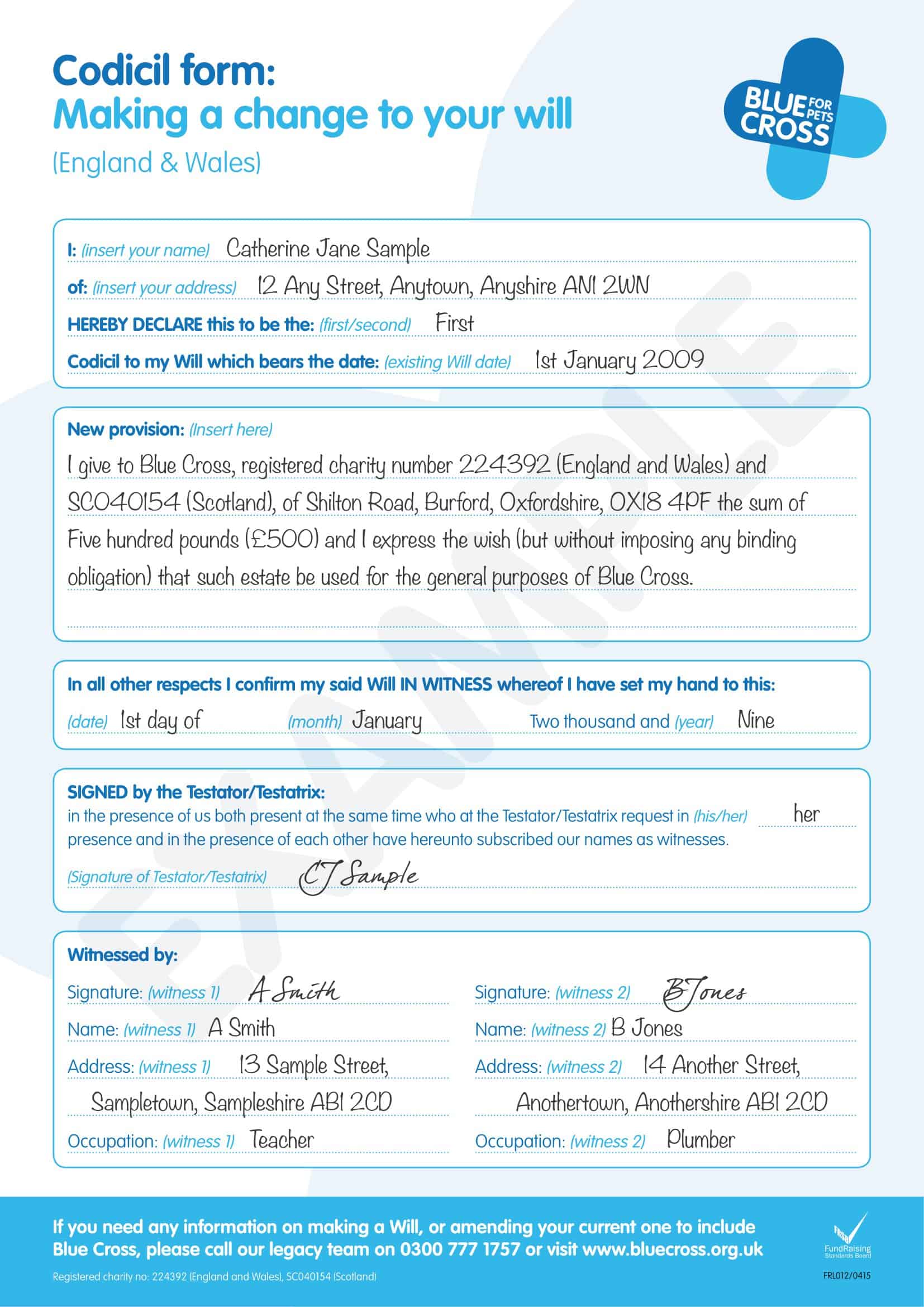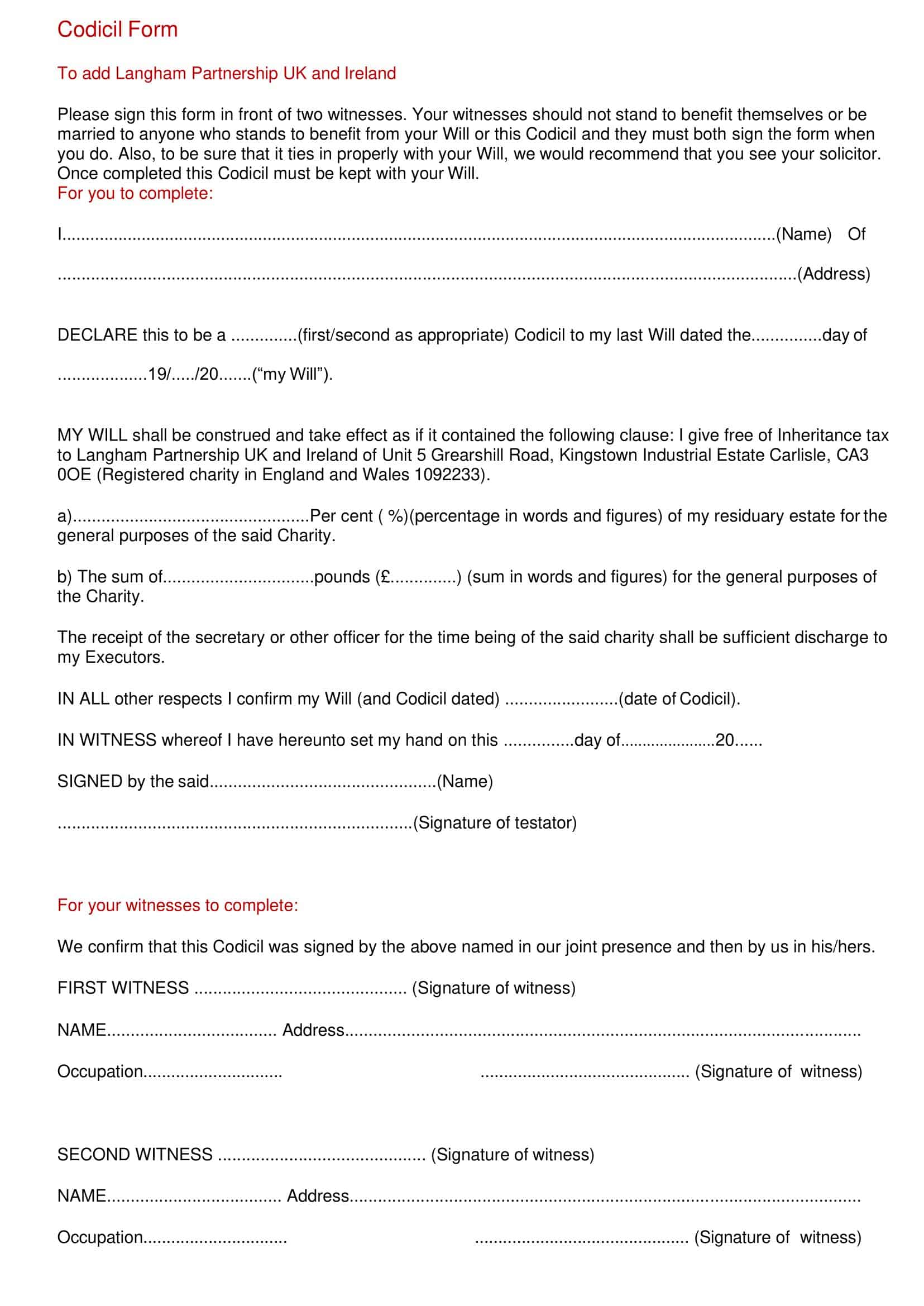A Codicil to Will Form is a legal document that is used to make changes to an existing will. It allows individuals to make changes to their will without having to create a new one entirely. This can include adding or removing beneficiaries, changing the distribution of assets, or revoking a previous bequest.
A Codicil to Will Form is a simple and effective way to update a will and ensure that it reflects the individual’s current wishes and circumstances. However, it is important to keep in mind that creating a new will is generally considered a better practice than making many changes to an existing one via codicils, as it ensures that the will is accurate and up to date.
Table of Contents
Codicil to Will Templates
Codicil to will templates are pre-designed documents that provide a structured format for creating legal amendments or modifications to an existing last will and testament. These templates offer a convenient and organized way to make changes to a will without having to entirely rewrite the original document.
Codicil to will templates typically include sections that allow individuals to specify the desired changes or additions to their will, such as updating beneficiaries, altering inheritance amounts, including new assets or properties, or appointing new executors. They may also include spaces for signatures and witnesses, ensuring the legal validity of the codicil.
Using a codicil to will template helps individuals ensure that their wishes regarding the distribution of assets and estate management are accurately reflected, even after the initial creation of the will. The template provides a structured format that simplifies the process of making amendments and maintains consistency with the original will.
Codicil Definition & Meaning

A codicil is a legal document that is used to make changes or additions to an existing will. It is a supplement or an amendment to a will, rather than a replacement of a will. It allows individuals to make changes to their will without having to create a new one entirely. It is a way to update the will to reflect changes in personal circumstances or to correct any errors in the original will.
The codicil must be executed with the same formalities as the original will and must be incorporated in the will by reference. A codicil is a simple and effective way to update a will but it’s important to keep in mind that creating a new will is generally considered a better practice than making many changes to an existing one via codicils, as it ensures that the will is accurate and up to date.
When to Use a Codicil for a Will
A codicil for a will is used when an individual wants to make changes or additions to their existing will without creating a new one entirely. Some common situations where a codicil may be used include:
Adding or removing beneficiaries: If an individual wants to add or remove a beneficiary from their will, they can use a codicil to make the necessary changes.
Changing the distribution of assets: If an individual wants to change the distribution of their assets, they can use a codicil to make the necessary changes.
Revoking a previous bequest: If an individual wants to revoke a previous bequest, they can use a codicil to make the necessary changes.
Correcting errors in the original will: If an individual discovers errors in their original will, they can use a codicil to make the necessary corrections.
Reflecting changes in personal circumstances: If an individual’s personal circumstances change, they can use a codicil to update their will to reflect these changes.
How to change a will
Amending a will, also known as making a codicil, is a process that requires careful consideration and attention to detail. The following steps can help guide you through the process of amending a will:
Review the original will
Before amending a will, it is important to review the original will to ensure that the changes you wish to make are necessary and that the proposed amendment is in compliance with any restrictions or guidelines set forth in the original will.
Identify the changes to be made
Clearly identify the changes that you wish to make to the will. This can include adding or removing beneficiaries, changing the distribution of assets, or revoking a previous bequest.
Create the codicil
A codicil is a legal document that is used to make changes to an existing will. It should be written in a clear and concise manner, and it should be executed with the same formalities as the original will.
Sign and date the codicil
The codicil must be signed and dated by you and the same number of witnesses as required for the original will.
Attach the codicil to the will
The codicil should be physically attached to the original will and incorporated in the will by reference.
Review the will and codicil together
After attaching the codicil, review the will and the codicil together to ensure that the changes are clear and accurate.
Keep the will and codicil in a safe place
Keep the will and codicil in a safe place where they can be easily located and accessed by your executor.
Is it possible to amend my will without the help of a lawyer?
Yes, you can add a codicil to your will without a lawyer, as long as you follow the proper procedures and ensure that the codicil is executed with the same formalities as the original will. It is important to ensure that the proposed amendment is in compliance with any restrictions or guidelines set forth in the original will and that the changes are clear and accurate.
However, creating a new will is generally considered a better practice than making many changes to an existing one via codicils, as it ensures that the will is accurate and up to date. It is important to keep in mind that laws vary by jurisdiction and it may be beneficial to consult with a legal professional to ensure that your codicil and will are legally binding. If you have any doubts or complex situations it is advisable to seek legal advice.
How to Write a Codicil to a Will
Writing a codicil to a will requires careful consideration and attention to detail. A codicil is a legal document that is used to make changes or additions to an existing will. It should be written in a clear and concise manner, and it should be executed with the same formalities as the original will. The following steps can help guide you through the process of writing a codicil to a will:
Step 1: Review the original will
Before writing a codicil, it is important to review the original will to ensure that the changes you wish to make are necessary and that the proposed amendment is in compliance with any restrictions or guidelines set forth in the original will.
Step 2: Identify the changes to be made
Clearly identify the changes that you wish to make to the will. This can include adding or removing beneficiaries, changing the distribution of assets, or revoking a previous bequest.
Step 3: Write the codicil
Start by writing the date on the top of the page, followed by a statement that it is a codicil to the will. Be specific and clear in identifying the changes that you are making to the original will, and reference the original will by date and location. For example, “I, [Name], on this date, being of sound mind and memory, do hereby make the following changes to my will, dated [date], which is located at [address].”
Step 4: Execute the codicil
The codicil must be signed and dated by you and the same number of witnesses as required for the original will. All parties should sign the codicil in the presence of each other.
Step 5: Attach the codicil to the will
The codicil should be physically attached to the original will and incorporated in the will by reference. This can be done by attaching it to the back of the original will or by placing it in a separate envelope that is clearly marked with the words “Codicil to the Will of [Name]” and the date of the codicil.
Step 6: Review the will and codicil together
After attaching the codicil, review the will and the codicil together to ensure that the changes are clear and accurate.
Step 7: Keep the will and codicil in a safe place
Keep the will and codicil in a safe place where they can be easily located and accessed by your executor.
FAQs
Do I need to have my codicil to will notarized?
Whether or not a codicil to will needs to be notarized depends on the laws of the jurisdiction in which you reside. Some states require that a codicil be notarized, while others do not. It is important to consult with a legal professional or the appropriate government agency in your area to determine the specific requirements for your codicil.
Can I make multiple changes to my will with a single codicil?
Yes, you can make multiple changes to your will with a single codicil, as long as the changes are clearly and accurately identified in the document. However, it is important to keep in mind that creating a new will is generally considered a better practice than making many changes to an existing one via codicils, as it ensures that the will is accurate and up to date.
Can I revoke a codicil to my will?
Yes, you can revoke a codicil to your will by executing a new codicil that specifically revokes the previous one or by creating a new will that revokes all previous wills and codicils.
Is a codicil to will legally binding?
A codicil to will is legally binding if it is executed with the same formalities as the original will and if it is in compliance with the laws of the jurisdiction in which you reside. It is important to consult with a legal professional to ensure that your codicil is legally binding.
Can a codicil to will be challenged in court?
A codicil to will can be challenged in court if there is evidence that it was executed under duress, fraud, or undue influence or if the testator (the person who made the will) lacked the capacity to make the changes. It is important to consult with a legal professional to ensure that your codicil is legally binding and to avoid any potential challenges in court.
Can a codicil to will be made after death?
No, a codicil to will must be made while the testator (the person who made the will) is still alive. It cannot be made after the testator’s death.
Can a codicil to will be made verbally?
No, a codicil to will must be made in writing and executed with the same formalities as the original will. Verbal codicils are not legally binding.
Is a codicil to will a public document?
No, a codicil to will is a private document. It is typically only made available to the testator, the executor of the will, and any other parties specifically named in the document.
Can a codicil to will be used to change the executor of the will?
Yes, a codicil to will can be used to change the executor of the will. It is important to consult with a legal professional to ensure that the change is executed correctly.
Can a codicil to will be used to change the guardian of a minor?
Yes, a codicil to will can be used to change the guardian of a minor. It is important to consult with a legal professional to ensure that the change is executed correctly and that it is in the best interest of the minor.
















































![Free Printable Roommate Agreement Templates [Word, PDF] 1 Roommate Agreement](https://www.typecalendar.com/wp-content/uploads/2023/06/Roommate-Agreement-150x150.jpg)
![Free Printable Credit Card Authorization Form Templates [PDF, Word, Excel] 2 Credit Card Authorization Form](https://www.typecalendar.com/wp-content/uploads/2023/06/Credit-Card-Authorization-Form-150x150.jpg)
![Free Printable Stock Ledger Templates [Excel,PDF, Word] 3 Stock Ledger](https://www.typecalendar.com/wp-content/uploads/2023/08/Stock-Ledger-150x150.jpg)
